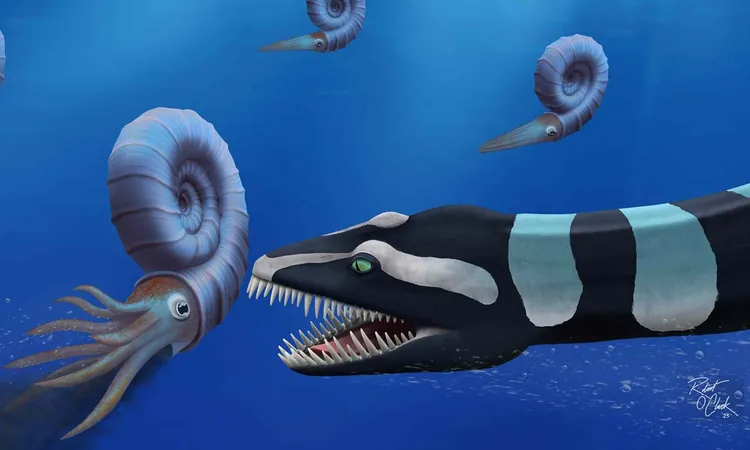
Unveiling a Stunning New Marine Predator: Meet Traskasaura sandrae
2025-07-17
Author: John Tan
A Remarkable Discovery on Vancouver Island
In a groundbreaking revelation, a long-necked marine predator discovered on Vancouver Island has been identified as a brand-new species. This fascinating creature, named **Traskasaura sandrae**, roamed the seas approximately 85 million years ago, and with a staggering length of 39 feet, it raises intriguing questions about its unique hunting strategies.
Digging Up Secrets of the Past
The initial bones of Traskasaura were unearthed in 1988 within the Haslam Formation, a geological layer formed when shallow seas covered what is now British Columbia. Community volunteers worked tirelessly over three summers to expose a remarkably intact skeleton, which later expanded to include more than fifty interconnected neck vertebrae, limbs, and crushing teeth indicative of its unusual feeding techniques.
An Ambush Predator Like No Other
What sets Traskasaura sandrae apart from its relatives? While most elasmosaurs used sideways sweeps to capture prey, researchers found that this creature's neck joints allowed a smooth downward motion, suggesting a striking ambush style—hovering silently above its targets before plunging down like a heron.
Innovations in Feeding and Swimming
Its anatomical features reveal even more about its lifestyle. The glenoid cavity of Traskasaura, which connects the upper arm to the body, is tilted to enhance swimming efficiency, enabling swift vertical movements. Its conical, crushing teeth, well-suited for eating the hard-shelled ammonites abundant in its environment, confirm its place as a formidable predator.
Life in the Late Cretaceous Era
During the Late Cretaceous, Vancouver Island lay at a latitude comparable to modern-day Oregon, surrounded by warm waters teeming with life. From sleek mosasaurs to early sharks, the area was rich in biodiversity, yet Traskasaura carved out a unique niche as a slow-moving stalker, relying on short bursts of speed to catch its prey.
Rewriting the Plesiosaur Family Tree
While traditionally classified as a plesiosaur, Traskasaura is positioned near the base of the elasmosaur lineage. The research suggests it diverged early from southern relatives but developed similar features later—an intriguing case of convergent evolution. This discovery highlights the importance of looking beyond singular traits, as the understanding of how these ancient creatures lived and hunted becomes more nuanced.
A Local Legacy and Recognition
The impressive skeleton of Traskasaura sandrae can now be seen at the Courtenay and District Museum, where visitors can marvel at vertebrae larger than their hands. It serves as a powerful reminder of the region's prehistoric past and the collaborative efforts of local collectors and researchers.
Honoring the Namesakes
The name **Traskasaura** pays tribute to the father-daughter duo, Michael and Heather Trask, who discovered the original fossil. The species name **sandrae** honors Sandra Lee O’Keefe, a dedicated advocate for breast cancer awareness. This naming tribute parallels the legacy of paleontologist Elizabeth Nicholls, who played a vital role in identifying the fossils in 2002.
Continuing the Journey of Discovery
As researchers continue to dissect the anatomy of Traskasaura sandrae, discussions about its function and evolutionary implications are sure to persist for years to come. This new addition to the paleontological record not only enriches our understanding of marine life in the Cretaceous but also reinvigorates interest in unlocking the mysteries of our planet's ancient past.



 Brasil (PT)
Brasil (PT)
 Canada (EN)
Canada (EN)
 Chile (ES)
Chile (ES)
 Česko (CS)
Česko (CS)
 대한민국 (KO)
대한민국 (KO)
 España (ES)
España (ES)
 France (FR)
France (FR)
 Hong Kong (EN)
Hong Kong (EN)
 Italia (IT)
Italia (IT)
 日本 (JA)
日本 (JA)
 Magyarország (HU)
Magyarország (HU)
 Norge (NO)
Norge (NO)
 Polska (PL)
Polska (PL)
 Schweiz (DE)
Schweiz (DE)
 Singapore (EN)
Singapore (EN)
 Sverige (SV)
Sverige (SV)
 Suomi (FI)
Suomi (FI)
 Türkiye (TR)
Türkiye (TR)
 الإمارات العربية المتحدة (AR)
الإمارات العربية المتحدة (AR)